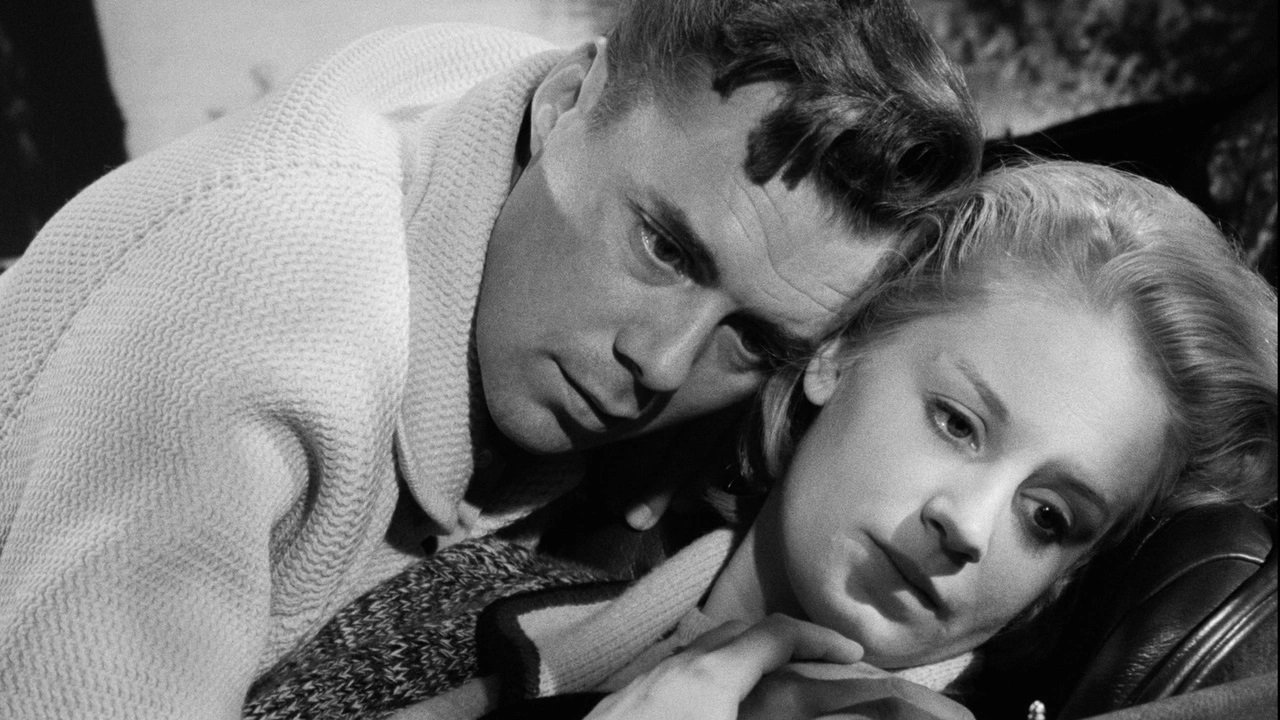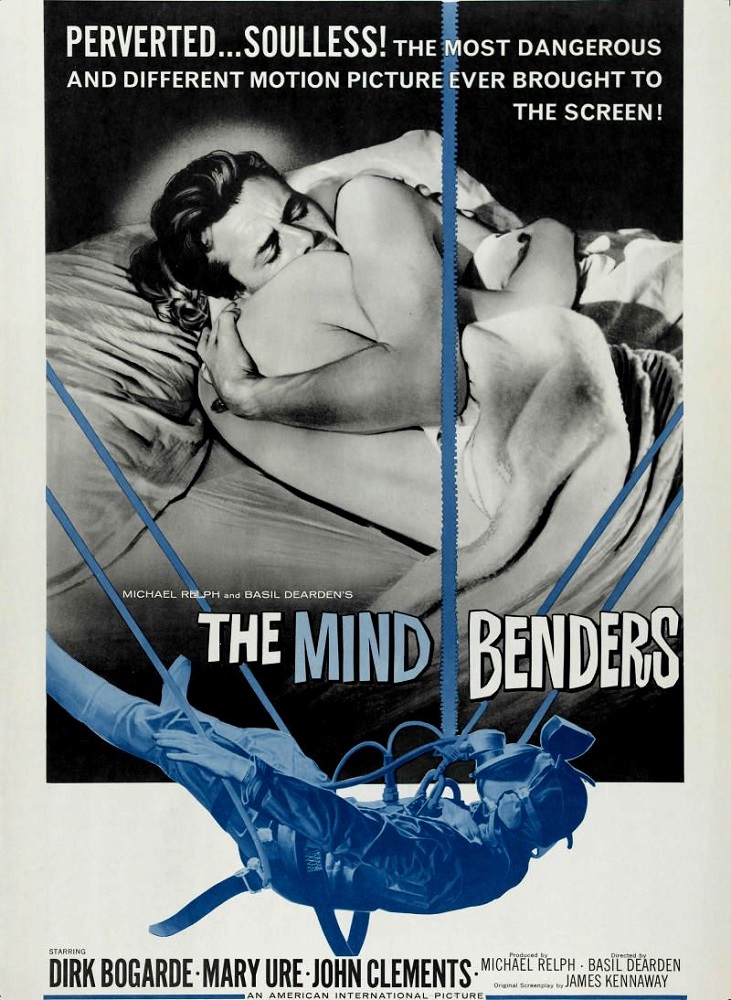Crew
Director – Basil Dearden, Screenplay – James Kennaway, Producer – Michael Relph, Photography (b&w) – Denys Coop, Music – Georges Auric, Music Conductor – Muir Mathieson, Makeup – Harry Frampton, Art Direction – James Morahan. Production Company – Novus Films Ltd.
Cast
Dirk Bogarde (Dr Henry Longman), Mary Ure (Oonagh Longman), John Clements (Major Dr Hall), Michael Bryant (Dr Tony Tate), Wendy Craig (Annabel), Harold Goldblatt (Professor Sharpey)
Plot
Professor Sharpey, a research scientist at Oxford, boards a train but in mid-journey suddenly opens the door and steps out of the carriage to his death. Investigating, secret service agent Major Hall finds a satchel containing hundreds of pounds beside the body and suspects that Sharpey, a known leftist sympathizer, was a traitor. He starts investigating Sharpey’s research into sensory deprivation at Oxford. Sharpey’s colleague Dr Henry Longman has gone absent from work after time spent in a sensory deprivation tank. In an effort to persuade Hall that Sharpey’s state of mind was due to the isolation tank not treason, Longman agrees to re-enter the tank. After spending eight hours in isolation, Longman emerges a mentally numbed zombie. Hall realizes that this state is akin to brainwashing and decides that in order to prove Sharpey’s innocence they need to demonstrate that the tank can affect a subject’s personality and alter long-held beliefs. Longman is placed back in the tank where Hall and Longman’s assistant Tate plant the suggestion that Longman’s wife Oonagh is emotionally unstable, trampish and that he no longer desires her, whereupon he is released. However, when they return several months later, they are shocked to find that Longman now treats his wife with contempt and openly carouses with other women.
The Mind Benders was one of several films in the 1960s concerning themselves with brainwashing themes. Notedly, The Mind Benders came out the same year as the classic The Manchurian Candidate (1962) and there were a number of other films on the theme over the next few years with the likes of 36 Hours (1965), The Groundstar Conspiracy (1972), The Mind Snatchers (1972), The Parallax View (1974), Who? (1974), Telefon (1977) and tv’s The Prisoner (1967-8). Interest in the tropic had been sparked by reports in the 1950s that during the Korean War the Chinese Communists had successfully brainwashed POWs captured into speaking out against the West. The Mind Benders also takes up the topical interest in the subject of isolation tank and sensory deprivation experiments, which became prominent in the 1950s – although elevates it to the level of Frankenstein science.
The film is made with the black-and-white kitchen sink realism that marked most British films, and in particular thrillers, of the period. At least for the first half-hour, The Mind Benders is dull. There is a captivating opening where Harold Goldblatt’s scientist gets aboard a train from Paddington to Oxford, sitting in a carriage as the others make witty and erudite jokes about Einsteinian Relativity, and then abruptly opens the door and jumps out. Thereafter though, as we get into the investigation, the film has a tendency to talk its subject out endlessly. Even star Dirk Bogarde gives his dialogue a theatrically overwrought delivery as though to impart some drama that the script does not provide.
The Mind Benders starts to come to life when we get to the scenes in the isolation tank. There is the fascinating image of Dirk Bogarde floating in the water, sinisterly underlit from below and the calm voice describing the changes of mood he is undergoing – irritability, heightened sensation, erotic hallucinations – before he descends into madness. It becomes even more fascinating when John Clements’ military-type decides that in order to prove what they are investigating, Dirk Bogarde must be imprinted while under and made to change a fundamental belief – convinced that his wife is unstable and untrustworthy.
During these scenes, director Basil Dearden happily employs many of the visual tricks used by John Frankenheimer in The Manchurian Candidate – of hyping tension via stark contrasts of shadow and light. There is something sinister to the changes that we see in Dirk Bogarde subsequently – how the scientists return several months later and see him treating his pregnant wife Mary Ure with coldness, contemptuously calling her “otter” and her later confession about how they went to Amsterdam and he rented one of the windows that the prostitutes sit in for her.

On the other hand, The Mind Benders takes one aback when one looks at its moral position. The scenes where John Clements’ investigator and Michael Bryant’s lab assistant casually conspire to brainwash Dirk Bogarde and alienate him from his wife have a cold chill. What is extraordinary is how the film seems to have no particular objection to their doing so. Moreover, Michael Bryant’s assistant has a clear attraction to and interest in Dirk Bogarde’s wife. His interest in brainwashing Bogarde is marred by a conflict of interests to say the very least – yet the film never chooses to comment on this at all.
There is an almost total lack of moral outrage about what they do to Dirk Bogarde throughout – at most a muted scene at the end where Michael Bryant admits that what they did was a mistake. In almost any modern film, the sympathies would have been radically different – rather than a calm Establishment figure, John Clements’ hero type would almost certainly be regarded as a Machiavellian villain.
The film climaxes with an extended scene where Mary Ure gives birth and Dirk Bogarde comes to her aid, where it is seen that he is able to overcome the conditioning by a realization of the joys of fatherhood. Whether this means that he also begins to treat her better is something that is never dwelt on.
Director Basil Dearden had come from a background in British quota quickies with his most famous work being the historical film Khartoum (1966). Dearden’s other genre films include:– The Halfway House (1944), a tapestry of tales set around a haunted inn; the first segment of the classic horror anthology Dead of Night (1945); the space mission comedy Man in the Moon (1960); and The Man Who Haunted Himself (1970) where Roger Moore is haunted by a doppelganger of himself.


